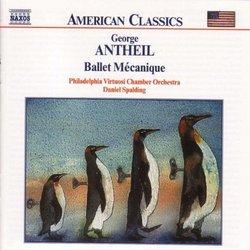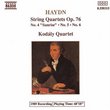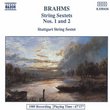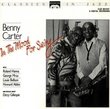| All Artists: Philadelphia Virtuosi Chamber Orchestra Title: Antheil: Ballet Mecanique Members Wishing: 0 Total Copies: 0 Label: Naxos American Release Date: 9/18/2001 Genres: Special Interest, Classical Styles: Chamber Music, Forms & Genres, Concertos, Historical Periods, Classical (c.1770-1830), Symphonies Number of Discs: 1 SwapaCD Credits: 1 UPC: 636943906026 |
Search - Philadelphia Virtuosi Chamber Orchestra :: Antheil: Ballet Mecanique
 | Philadelphia Virtuosi Chamber Orchestra Antheil: Ballet Mecanique Genres: Special Interest, Classical
George Antheil's reputation as the Bad Boy of Music (the title of his fascinating autobiography) was earned largely with his Ballet Mécanique, written to accompany an abstract silent film by the artist Fernand Leger. ... more » |
Larger Image |
CD DetailsSynopsis
Amazon.com George Antheil's reputation as the Bad Boy of Music (the title of his fascinating autobiography) was earned largely with his Ballet Mécanique, written to accompany an abstract silent film by the artist Fernand Leger. It was composed for player pianos and percussion, with harsh, driving rhythms, and it caused the kind of riots in Paris that were useful to a composer's reputation. Today, that reputation may keep Antheil from being taken seriously. But when you hear the Ballet (as rescored in 1953 for an early mono recording) today, it's a substantial and exciting piece of music, formally tight and not at all hard on 21st century ears. The remainder of this program shows more of Antheil's range. The Serenade is a lovely piece of Americana, with a particularly touching slow movement. The Symphony and Concert owe much to Stravinsky's "neoclassical" style; both hold up very well. Spalding drives the Ballet hard, and it sounds more frenetic than that old mono recording, but the music can take the heat. This and the remaining performances are splendidly played by the excellent chamber orchestra, and the recording is clear, well-balanced, and realistic in sound. Another Naxos winner. --Leslie Gerber Similarly Requested CDs
|
CD ReviewsThe Bad Boy and the Bad Boy Tamed 11/29/2001 (5 out of 5 stars) "The main problem with the early works of George Antheil, self-styled "Bad Boy of Music," is also its chief virtue: It's derivative of Igor Stravinsky. But then if you're going to slavishly follow a model, you probably couldn't choose a better one. In the Ballet Mechanique, Antheil's most famous work, you'll hear the percussion effects of "The Rite of Spring," "L'histoire," and especially "Les Noces." But you'll also note that the contours of the melodic snippets played by the tuneable percussion are Stravinskian as well, sounding like the Russian folk melodies that give "Les Noces" such impetus.To be fair to Antheil, his music has its own merits, for one thing being entirely trusted to the percussion and an eccentic mix of instruments at that, including airplane propellers and electric bells among the more standard piano, drums, glockenspiel, xylophones, and such. It does create a uniquely extravagant and arresting sound. And then the music's multirhythms and off-rhythms give it the enlivening thrust that so many of this century's percussion extravaganzas lack. Overall, an interesting and appealing piece.The "Symphony for Five Instruments" and "Concert Music for Chamber Orchestra" recall the neoclassical Stravinsky of the "Octet" and "Symphonies for Wind Instruments," but the quirky instrumentation of Antheil's symphony, with the prominence given to the sometimes clownish antics of the trumpet, abetted by the trombone, recall (or anticipate) Poulenc as well. Playful and enjoyable stuff despite its obvious hommage to Stravinsky. The "Concert" is more sullen and sober-sided and so is a bit more facelessly neoclassical.Perhaps my favorite work here is the relatively late (1948) "Serenade for Strings No. 1," a gentle, very American piece with a skittish, syncopated first movement that has elements of the barn dance along with what seems like Latin dance rhythms. The tender, deeply felt slow movement is the high point of the work. The agreeably tipsy last movement returns us to the dance. This piece shows that Antheil never lost his Stravinskian belief that, as the Russian master said, "Rhythm is all." The performances by the Philadelphia Virtuosi are indeed virtuosic but also highly sympathetic and even loving in the serenade. The recording, made in the War Memorial building of Antheil's native Trenton, New Jersey, is wonderfully vibrant and detailed. In all, a fine tribute to this mostly forgotten composer that should garner renewed interest in his music." New Anthiel Recording Hits Budget Market Cameron Logan | Hartford, Ct, USA | 10/23/2001 (4 out of 5 stars) "Most readers will question the validity of introducing the works of such a little-known composer to the shelf, but this CD shows that even historical underdogs deserve their moment in the sun. The Philadelphia Virtuosi bring vibrancy and energy to Antheil's vivid soundscapes, which are amoung the most progressive works of the 1920's. To put Antheil's contributions into relief, the Ballet Mechanique on the present recording was first performed in 1926, predating the other famous avant-garde work for percussion ensemble of the era, Edgard Varese's Ionasation, of 1931-33. Of additional note on the record is the exemplary solo playing of the participants in Antheil's quirky quintet, the Symphony for Five Instruments of 1923. However, for those interested in the profound pinnacles of early 20th Century music, this disc may fall short of such inflated expectations. The music on this disc is primarily intended to divert and to delight. Influences of the Stravinsky's L'Histoire du Soldat and of the early works of the so-called "Les Six" group conjure a reasonable example of what Antheil's witty scores have to offer. The program notes by Joshua Cheek unfortunately leave much to the imagination of the listener. For instance, the respective ensembles of the Symphony and the Concert are not enumerated, leaving the listener guessing as to the timbres he is hearing. Otherwise, congratulations to the Philadelphia Virtuosi and to Naxos for an interesting, welcome program with fine playing, polished sound and an alluring price tag." Fine illustration of George Antheil's art Steven A. Peterson | Hershey, PA (Born in Kewanee, IL) | 08/12/2008 (4 out of 5 stars) "George Antheil styled himself as the "Bad Boy of Music." As one listens to this CD, one is not so sure why people might have said that. He clearly was a capable composer and his music is worth listening to.
The CD is titled after one of his better known works, "Ballet Mecanique." This and the other works on this CD are played nicely by the Philadelphia Virtuosi Chamber Orchestra, under the direction of Daniel Spalding. The "Ballet Mecanique" was first performed in France in 1926, reputedly to good reviews. As the liner notes put it, "Notorious for its orchestra of pianos, percussion, electric buzzers, and aeroplane propellers, 'Ballet' was a summation of Antheil's involvement with futurism." What of the "Ballet"> It is a very energetic piece, a dynamic work. It is easy to listen to and enjoy. It does use strange instruments (such as buzzers and propellers) and stranger combinations of instruments; one critic referred to this work as an example of "demented modernism." Still, the energy of this piece is infectious. One can see this as in the tradition of Stravinsky (note what other reviewers say). Piano and percussion add an interesting element to the whole of the composition. The middle segment becomes quieter, even contemplative. Then, the energy returns for a dramatic close. It's a bit different. I tend not to enjoy more experimental music, but this surely works for me! Also on this CD are some of his other signature pieces, such as "Serenade for String Orchestra," "Symphony for Five Instruments," and "Concert for Chamber Orchestra." Overall, I think that this is worth a listen, exposing the listener to one of America's more intriguing composers of the early part of the century. " |

 Track Listings (8) - Disc #1
Track Listings (8) - Disc #1








